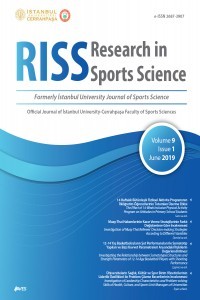Pliometrik Antrenmanların Judocularda Statik Denge Üzerine Etkisi
Judo, pliometrik antrenman
Effect of the Plyometric Training on Static Balance of Judokas
Judo plyometric training, balance,
___
- Soyuer F, İsmailoğulları (2009). S. Yaşlılık ve denge. Türk Serebrovasküler Hastalıklar Dergisi; 1: 1-5. Spirdus WW, 1995. Balance posture and locomotion In:Phiyscal Dimensions of aging . Human Kinetics Champaing, İllionis, 152-185.Okubo J, Watanabe I, Takeya T, (1979). Lufluance of foot position and visual field condition in the examination of equilibrium funetion and sway of centre of gravity in normal persons Agressolojie. 20: 127-132Yağcı N, Cavlak U, Şahin G. (2004). İşitme engellilerde denge yeteneğinin incelenmesi üzerine bir çalışma. KBB Forum, 2004;3:45-50. Singer R, 1980. Motor Learning and Human Performance. Mac Millan CO. 199-214.
- Tetik S, Koç MC, Atar Ö, Koç H. (2013). Basketbolcularda statik denge performansı ile oyun değer skalası arasındaki ilişkinin incelenmesi. Türkiye Kickboks Federasyonu Spor Bilimleri Dergisi; 6:9-17.Kutlu, M., Gür, E. Karahüseyinoğlu, M.F., Kamanlı, A., (2001). “Pliometrik Antrenmanın Genç Futbolcuların Anaerobik İşlerine Etkisi” Gazi Bed. Eğt. ve Spor Bil. Dergisi, 6(4):37-43 Gordon, C.C., Chumlea, C.C. ve Roche, A.F., (1988). Stature, recumbent length and weight. İçinde (Eds) Lohman, T.G., Roche, A.F. & Marorell, R. anthropometric standardization reference manual. Illinois: Human Kinetics Books
- Cachupe, W. J., Shifflett, B., Kahanov, L., & Wughalter, E. H. (2001). Reliability of biodex balance system measures. Measurement in physical education and exercise science, 5(2), 97-108.Claessens, A., Bennen, G., Wellens, R., Geldof, G., (1987). Somatotype And Bady Structure Of World Top Judo İsts, J. Sports Med. 27: 105-112İmamoğlu O., Kishah N.F., Çebi M., İmamoğlu.H. (1999). "Türk Judo Erkek Milli Takımında Vücut Kompozisyonu Parametrelerin İncelenmesi" Erzurum Atatürk Üniversitesi Beden Eğitimi Ve Spor Yüksekokulu Dergisi,C.I,S.I,Sh.12-18Arazi H., Asadi A. (2011). The Effect Of Aquatic And Land Plyometric Training On Strength, Sprint, And Balance Iin Young Basketball Players. Journal Of Human Sport & Exercıse, Volume 6, Issue 1.
- Verhagen, E., Bobbert, M., Inklaar, M., Kalken, V. M., Allardvan, D. B. A., Bouter, L., Mechelen, V. W. (2005). The Effect of a Balance Training Programme on Centre of Pressure Excursion in One-Leg Stance, Clinical Biomechanics, 20, pp 1094-1100Chiang, C.C. Chiang, J.Y., Shiang, T.Y (2000). The Comparison Of Balance Ability Between Judo Players And Non- Athletes. 18 International Symposium on Biomechanics in Sports). Hong Kong, China.
- Sterkowıcz S. Coordination Motor Abilities Of Judo Contestants at Different Age. 2012.Perrin, P., Schneider, D., Deviterne, D., Perrot, C., Constantinescu, L. (2002). Judo, Beter Than Dance, Develops Sensorimotor Adaptabilities İnvolved in Balance Control. Gait Posture. 2002;15:187-194.Altay, F. (2001). Ritmik Cimnastikte İki Farklı Hızda Yapılan Chaine Rotasyon Sonrasında Yan Denge Hareketinin Biyomekanik Analizi, Hacettepe Üniversitesi Sağlık Bilimleri Enstitüsü Doktora Tezi, Ankara.Davlin, C.D. Dynamic Balance in High Level Athletes. Percept.Mot. Skills. 2004; 98: 1171-1176.
- Başlangıç: 2019
- Yayıncı: İstanbul Üniversitesi-Cerrahpaşa
Spor Yoluyla Farkındalık Gelişimi Etkinliğinin Özel Gereksinimli Bireylere Yönelik Tutuma Etkisi
Sporcuların Sosyal Güvenlik Bilgi Düzeylerinin İncelenmesi
Dilek AMCAOĞLU, Ahmet Azmi YETİM
Pliometrik Antrenmanların Judocularda Statik Denge Üzerine Etkisi
Ahmet UZUN, Önder KARAKOÇ, Ömer Can GÖKSU, Selami YÜKSEK
Yüzme Havuzlarındaki Suda Boğulma Vakalarının İncelenmesi
Adnan TURGUT, Ali IŞIN, Eren AKDAĞ
Lise Öğrencilerinin Öz Güven Düzeylerinin Karşılaştırılması
Hakkı ÇOKNAZ, Mükremin YILDIZ, Engin ERBİL, Hamit ALTINTAŞ
Şentürk KURT, Betül BAYAZIT, Özlem KESKİN, Mehmet Yavuz TAŞKIRAN
